| Srl | Item |
| 1 |
ID:
162507
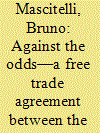

|
|
|
|
|
| Summary/Abstract |
The European Union (EU) and Australia have embarked officially on a free trade agreement (FTA) negotiation process, a procedure expected to last no less than 5 years. Public pronouncements from both sides which announced the beginning of the process of negotiating an FTA marked a significant departure from the well-known tensions and difficulties which date back to the late 1950s. British entry into the then European Economic Community in 1973 meant that it had to align its trade policies with the much contested European Common Agricultural Policy (CAP). This had been implemented in the late 1960s and provided limitless reasons for antagonism between Australia and the EU. Yet, over time, the trade agenda changed for both sides with new actors and new agreements, and some of the previous machinery no longer providing the liberalisation of trade as intended. Both the EU and Australia have moved on—some of this change due to new political actors and new economic realities. Despite the tortured history between them, and mindful that some might be sceptical about this change of heart, real politik often imposes its own political will and the new needs may well be in sharp contrast to the past relationships. The prospect of an FTA shows how the trappings of history might be side stepped by a stronger, almost opportunistic, sense of economic benefits however small they might appear.
|
|
|
|
|
|
|
|
|
|
|
|
|
|
|
|
| 2 |
ID:
021759
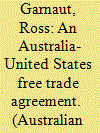

|
|
|
|
|
| Publication |
April 2002.
|
| Description |
123-141
|
|
|
|
|
|
|
|
|
|
|
|
|
|
|
|
| 3 |
ID:
052726
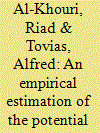

|
|
|
| 4 |
ID:
142816
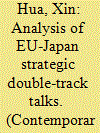

|
|
|
| 5 |
ID:
116571
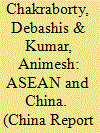

|
|
|
|
|
| Publication |
2012.
|
| Summary/Abstract |
ASEAN and China share a complex relationship in economic terms; while they collaborate in several spheres, conflict of interests is not uncommon either. The proposal for an ASEAN-China Free Trade Agreement (ACFTA) was floated in 2000, and the agreements covering merchandise trade, services trade and investment collaboration were signed in 2004, 2007 and 2009 respectively. ASEAN countries agreed to consider China as a market economy in the course of the negotiations and the ACFTA has resulted in several benefits for both parties, including tariff reduction on substantial number of product lines, considerable growth in merchandise and services trade volume, deepening of intra-regional production networks, regional cooperation on infrastructural development and so on. However, rapid growth of Chinese imports in ASEAN markets and expanding trade deficit generates apprehension in the grouping over potential domestic restructuring. Subisidies provided by the Chinese government to its domestic players also compound the problem. This article concludes that ASEAN countries need to augment their competitiveness through coordinated efforts on the one hand, and jointly negotiate with China to curb the disruptive effects of the latter's incentive programmes, on the other.
|
|
|
|
|
|
|
|
|
|
|
|
|
|
|
|
| 6 |
ID:
094546
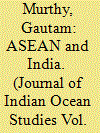

|
|
|
| 7 |
ID:
057158
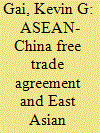

|
|
|
| 8 |
ID:
051986
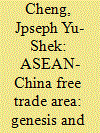

|
|
|
|
|
| Publication |
June 2004.
|
| Summary/Abstract |
The Asia-Pacific region's vulnerabilities to the consequences of globalisation were vividly revealed by its financial crisis in 1997-98. ASEAN states considered the US and APEC less than helpful during the crisis, and they found the conditionalities imposed by the IMF unpalatable. But ASEAN as a regional organisation has been much weakened, and it has been working hard to revive its influence. The 'ASEAN plus 3' approach has been perceived as an important means to strengthen ASEAN's status and relevance. The ASEAN-China Free Trade Area is undoubtedly an outstanding achievement of this approach; but ASEAN has been trying to keep its options open. On the other hand, China has been concerned with the danger of a deterioration in Sino-American relations and the increasing distrust between Tokyo and Beijing. Improvement of China-ASEAN relations therefore assumes increasing significance in China's regional policy; and enhancing mutual interests and interdependence is the best way to erode the ASEAN states' perception of the 'China threat'. But China must not neglect the interests of Japan and South Korea or underestimate ASEAN's resistance to the exclusion of the US and its desire to maintain a balance of power in the region. The ASEAN-China Free Trade Area, hopefully, should also facilitate the narrowing of the gap between the more developed and the developing ASEAN members, as well as that between the more prosperous coastal provinces and the poor interior provinces in China. In many ways, the establishment of the ASEAN-China Free Trade Area represents a challenge to what can be achieved in the mutual engagement process.
|
|
|
|
|
|
|
|
|
|
|
|
|
|
|
|
| 9 |
ID:
113902
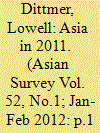

|
|
|
| 10 |
ID:
079466


|
|
|
| 11 |
ID:
046593
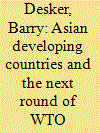

|
|
|
|
|
| Publication |
Singapore, Institute of Defence and Strategic Studies, 2001.
|
| Description |
21p.
|
| Series |
IDSS working paper; no. 18
|
|
|
|
|
|
|
|
|
|
|
|
Copies: C:1/I:0,R:0,Q:0
Circulation
| Accession# | Call# | Current Location | Status | Policy | Location |
| 045067 | 382.9/DES 045067 | Main | On Shelf | General | |
|
|
|
|
| 12 |
ID:
108704


|
|
|
|
|
| Publication |
2011.
|
| Summary/Abstract |
Agricultural liberalization is one of the most contentious trade issues in Japan and Korea. Yet, important differences characterize the Japanese and Korean governments' positions on agricultural liberalization when negotiating on free trade agreements (FTA). The Korean government supports substantial agricultural liberalization, whereas the Japanese government is reluctant to abandon farm interests even at the risk of undermining its FTAs. Given strong similarities in their agricultural structure and politics, how do you explain divergent government positions between Japan and Korea? The structure of a country's domestic trade governance largely explains the Japanese and Korean governments' varying approach to agricultural liberalization during FTA negotiations. Domestic trade governance refers to the decision-making structure and process on foreign economic policies. Cohesive domestic trade governance enabled the Korean government to pursue agricultural liberalization under the broader national agenda of promoting trade through FTAs. In contrast, fragmented domestic trade governance gave disproportionately larger weight to agricultural interests within the Japanese government, ultimately allowing agriculture to undermine the success of Japan's FTAs.
|
|
|
|
|
|
|
|
|
|
|
|
|
|
|
|
| 13 |
ID:
092137
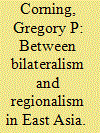

|
|
|
|
|
| Publication |
2009.
|
| Summary/Abstract |
This paper examines economic regionalism in East Asia with a focus on the key issues in harmonizing bilateral free trade agreements. The ASEAN+1 free trade agreements with China, South Korea and Japan represent the first attempts to structure cooperation in trade across Southeast and Northeast Asia. It is therefore important to examine the coverage of these agreements and the extent to which they actually liberalize trade. This study focuses on major choices made in the negotiation of the ASEAN-Japan Comprehensive Economic Partnership Agreement and the ways in which these choices help or hinder the consolidation of economic regionalism. The results achieved in the ASEAN-Japan Comprehensive Economic Partnership Agreement are limited at best. The agreement does establish some new areas of cooperation among the signatories but fails to address important issues for regionalism such as labor mobility. It also makes limited progress in harmonizing and liberalizing rules of origin. The ASEAN-Japan Comprehensive Economic Partnership Agreement applies product-specific rules to fewer categories of goods than most of Japan's bilateral agreements with ASEAN members but those rules in place are still very restrictive. Moreover, the parties to the ASEAN-Japan Comprehensive Economic Partnership Agreement have the option of applying the rules of their bilateral agreement if it provides more favorable treatment. Thus, there is no guarantee the more liberal terms of the ASEAN-Japan Comprehensive Economic Partnership Agreement will be applied.
|
|
|
|
|
|
|
|
|
|
|
|
|
|
|
|
| 14 |
ID:
061222


|
|
|
|
|
| Publication |
Jan-Apr 2005.
|
| Summary/Abstract |
The Japanese government today is actively and strategically choosing among various institutional forums to deal with its trade partners, namely bilateral venues, multilateral settings, and even preferential regional arrangements. This ongoing high-profile institutional selection is somewhat unprecedented for Japan, and demands a review of the historical and analytical reasons that drive decisionmakers to select one forum over another. Overall, the Japanese case suggests that the aggregate trade forum choices are influenced both by the desire to institutionalize mechanisms for stabilizing a range of expectations and by the necessity of guaranteeing market access and protection of investment in the fastest time possible.
|
|
|
|
|
|
|
|
|
|
|
|
|
|
|
|
| 15 |
ID:
059543
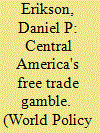

|
|
|
|
|
| Publication |
Winter 2004-05.
|
|
|
|
|
|
|
|
|
|
|
|
|
|
|
|
| 16 |
ID:
069305
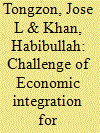

|
|
|
| 17 |
ID:
185662
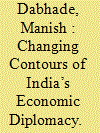

|
|
|
|
|
| Summary/Abstract |
This article explores India’s economic diplomacy since its early years of Independence, from the margins to a relative significance in the global economic hierarchy. It begins by identifying the constant, governing first principles and core objectives of India’s economic diplomacy that have remained constant over the years. The first three sections broadly embody the distinctive phases of India’s economic diplomacy, each laced with turning points, challenges and shifts entailed therein. The article ends with a concluding section that provides an analysis of India’s economic diplomacy in terms of broader trends, current challenges and the road ahead in the policy-relevant future.
|
|
|
|
|
|
|
|
|
|
|
|
|
|
|
|
| 18 |
ID:
147534
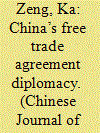

|
|
|
|
|
| Summary/Abstract |
This article assesses the relative importance of political and economic factors in shaping China’s free trade agreement (FTA) strategy since the country’s accession to the World Trade Organization (WTO) in 2001. Event history analysis of the time lapse before China signed an FTA with a given partner country lends substantial support to arguments emphasizing the political motivations behind China’s choice of FTA partner. The Chinese leadership has undoubtedly signed more FTAs with countries that have similar state preferences. However, there is far less overwhelming evidence to suggest that China’s FTAs are motivated by economic considerations. While Beijing has indeed signed more FTAs with countries on which it depends heavily for imports, there is scant evidence to show that China’s FTAs are designed to enhance market access abroad, or to secure essential supplies of raw materials. Finally, the study analyses the importance of multilateral and regional trade liberalization in shaping China’s FTA policy choices, and finds that, as a major trading nation, China may not be significantly influenced by the competitive dynamics of regional trade liberalization when formulating its FTA strategy.
|
|
|
|
|
|
|
|
|
|
|
|
|
|
|
|
| 19 |
ID:
059512
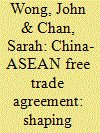

|
|
|
|
|
| Publication |
May-Jun 2003.
|
|
|
|
|
|
|
|
|
|
|
|
|
|
|
|
| 20 |
ID:
054090
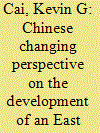

|
|
|